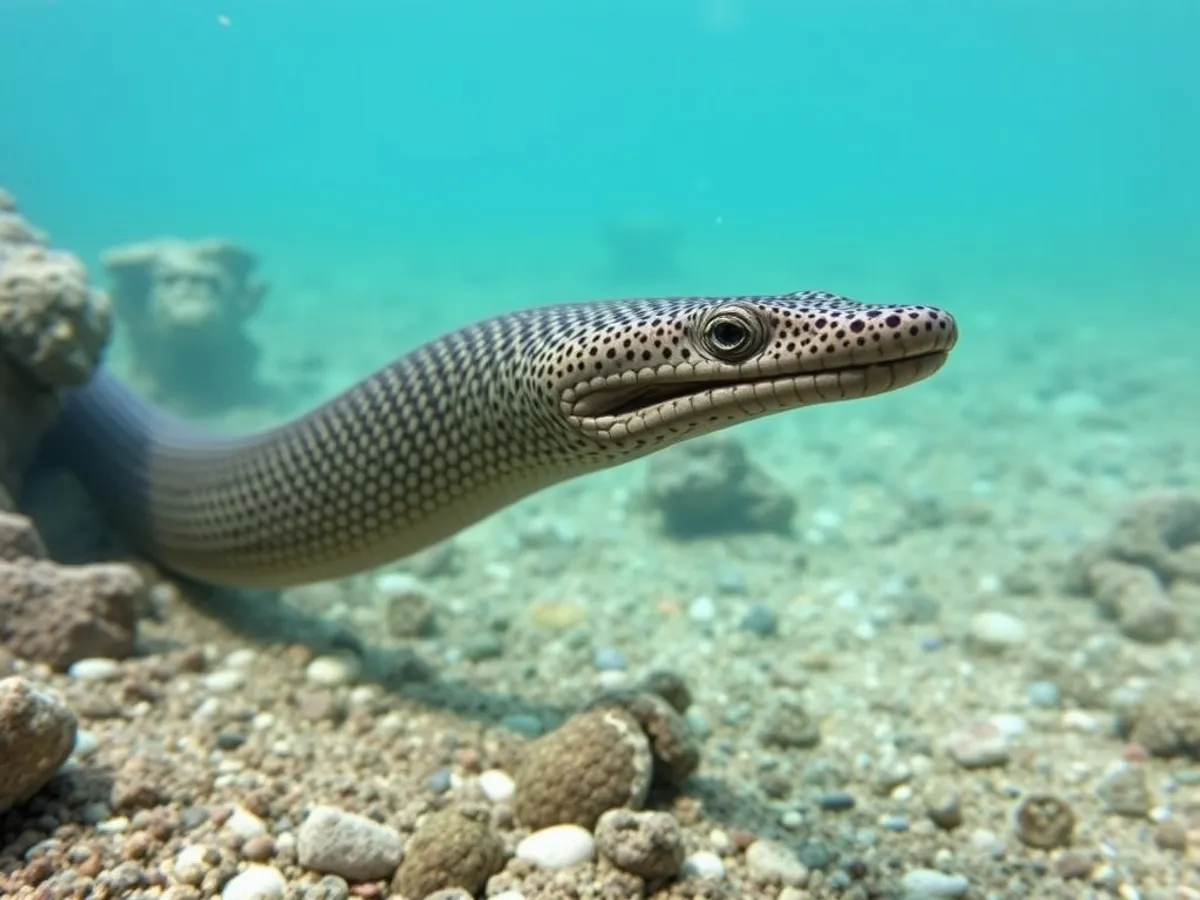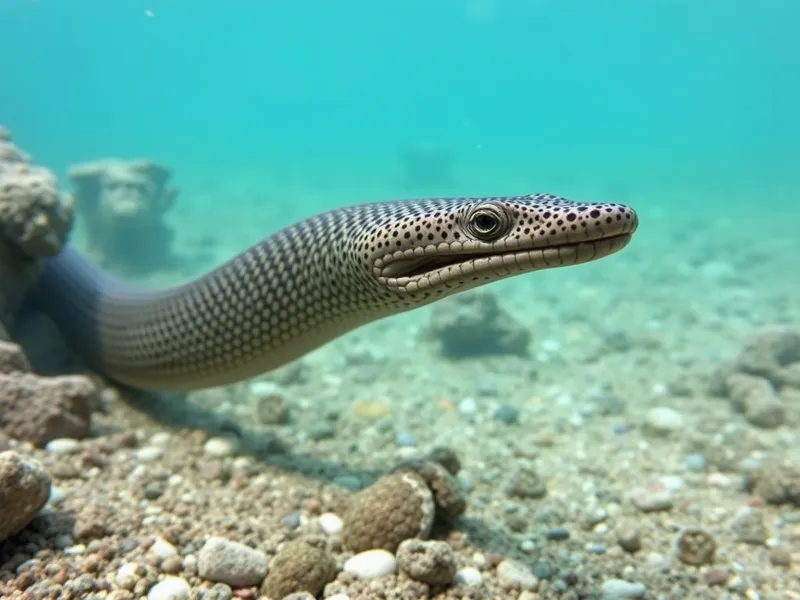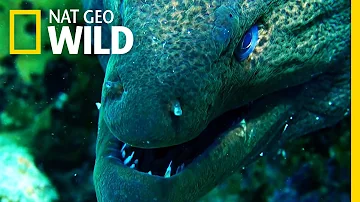
Moray Eel Leech
Zeylanicobdella arugamensis

Meet the Moray Eel Leech
The Moray Eel Leech is a parasitic annelid commonly found attached to the skin or gills of moray eels and other marine fish in tropical and subtropical waters. This leech is elongated, flexible, and capable of expanding significantly as it feeds on the blood of its host. It is known for its ability to survive in both marine and brackish environments, adapting well to various saline conditions. The Moray Eel Leech plays a role in the marine ecosystem by regulating fish populations and sometimes serving as a vector for certain fish diseases. Its presence is often an indicator of fish health in coral reef habitats.
Classification
Invertebrate
Habitat
Coastal marine and brackish waters, often associated with coral reefs and estuaries
Diet
Parasitic (feeds on the blood of fish)
Lifespan
1-2 years
Conservation
Least Concern
Weight
1-3 grams
📖Fascinating Facts
Disease Vector
Moray Eel Leeches can transmit blood-borne parasites and pathogens between fish, impacting fish health in aquaculture and wild populations.
Salinity Adaptation
This species tolerates a wide range of salinities, allowing it to thrive in both marine and brackish environments such as estuaries and lagoons.
Blood Feeding
The leech uses a specialized proboscis to pierce the skin of its host fish and feed on their blood, sometimes leading to anemia or secondary infections in heavily infested hosts.
📋Detailed Description
Zeylanicobdella arugamensis, commonly known as the Moray Eel Leech, is a marine parasitic annelid belonging to the family Piscicolidae. Adult individuals typically measure between 10 and 30 mm in length, with a dorsoventrally flattened, elongated, and highly flexible body that allows them to maneuver easily over the surface of their hosts. The anterior end is equipped with a small, muscular oral sucker, while the posterior sucker is larger and used for firm attachment to fish hosts, particularly around the gills and skin folds. The leech's body is translucent to greyish-brown, often taking on a reddish hue after feeding due to ingested blood. Z. arugamensis lacks eyes but possesses well-developed sensory papillae that detect chemical and tactile cues from potential hosts. Their cuticle is thin but highly elastic, enabling significant expansion during feeding. This species is an obligate ectoparasite, primarily targeting moray eels (family Muraenidae), but it has also been recorded on groupers, snappers, and other reef-associated fish. Moray Eel Leeches are adapted to both marine and brackish conditions, tolerating salinities from 10 to 35 ppt, which allows them to exploit a wide range of habitats from coral reefs to estuarine environments. They play a role in the transmission of blood-borne fish pathogens and can influence host health and behavior. Their presence is often used as a bioindicator for fish health and environmental quality in reef systems.
💡 Did you know?
Despite their name, Moray Eel Leeches do not exclusively parasitize moray eels—they are capable of infesting a variety of marine fish species.
🔬Research & Sources
🎭Behavior & Social Structure
Zeylanicobdella arugamensis exhibits a specialized parasitic lifestyle, spending the majority of its life attached to the external surfaces of fish hosts. It is primarily nocturnal, with peak feeding activity occurring during the night when fish are less active and more vulnerable. The leech uses its anterior sucker to pierce the host's skin, secreting anticoagulant enzymes to facilitate blood feeding. Feeding bouts may last from several minutes to over an hour, after which the leech may detach and seek another host or remain attached for extended periods. Moray Eel Leeches are generally solitary, with multiple individuals occasionally found on a single host, especially in environments with high fish densities. They exhibit limited locomotion, relying on undulatory movements and their suckers to crawl across substrates or between hosts. When not feeding, they may hide in crevices or under rocks, reducing exposure to predators and environmental stressors.
👶Reproduction & Life Cycle
Z. arugamensis is hermaphroditic, possessing both male and female reproductive organs. Copulation occurs via reciprocal sperm exchange, often while attached to a host or in close proximity to one. Fertilized eggs are deposited in gelatinous cocoons, which are attached to hard substrates such as rocks, shells, or submerged vegetation in the host's environment. Each cocoon may contain 10–30 eggs. Embryonic development is direct, with no free-swimming larval stage; juveniles hatch as miniature versions of the adults after an incubation period of approximately 10–14 days, depending on water temperature. There is no parental care post-oviposition. Breeding can occur year-round in tropical environments but may peak during warmer months when host fish are more abundant and active.
🛡️Adaptations & Survival
The Moray Eel Leech has evolved several key adaptations for its parasitic lifestyle. Its muscular suckers provide strong attachment to slippery fish surfaces, even in turbulent waters. The secretion of anticoagulants and anesthetics in its saliva allows it to feed undetected and prevent host blood from clotting. Its flexible, expandable body accommodates large volumes of ingested blood, supporting prolonged periods between feedings. The ability to tolerate a wide range of salinities enables colonization of both marine and brackish habitats. Sensory papillae compensate for the absence of eyes, allowing the leech to detect host cues. Its reproductive strategy, with protected egg cocoons and direct development, enhances offspring survival in variable environments.
📚Research Sources
🎨Cultural Significance
There is limited direct cultural significance associated with Z. arugamensis. However, its presence is of interest to fishers and aquaculturists due to its impact on fish health. In some regions, infestations have prompted traditional fish health management practices. The leech is occasionally referenced in local folklore as a symbol of parasitism or as an indicator of environmental imbalance, but it does not have a prominent role in mythology or traditional medicine.
🔬Recent Research & Discoveries
Recent research has focused on the role of Z. arugamensis as a vector for hematozoan parasites and viral pathogens in marine fish, with implications for both wild fisheries and aquaculture. Molecular studies have clarified its phylogenetic relationships within Piscicolidae and have identified cryptic diversity within the species complex. Investigations into its salinity tolerance and physiological adaptations have provided insights into its broad ecological niche. Ongoing studies are examining the impact of environmental stressors, such as pollution and climate change, on leech-host dynamics and prevalence in coral reef systems.
🎥Wildlife Videos

Moray Eels are Straight out of Alien
----------- SOCIAL MEDIA https://www.instagram.com/animalogicshow/ https://twitter.com/animalogicshow ...
Animalogic

Moray Eel vs. Whitetip Reef Shark | Shark vs. Predator
#NatGeoWILD #Sharks #MorayEels About Sharkfest: Put on your wetsuit to swim with the sharpest of the sea. This is the ...
Nat Geo Animals

Nature's Perfect Predators Moray Eel
Webisode I edited and narrated for Discovery. Sorry about any informational errors or incorrect animals; the company I created ...
Greg Beaton

Giant Moray Eel The Wildlife Man TV Series
Thank you to our Podcast Sponsors: Soodox - https://www.soodox.com/ Pure Vitality - https://www.purevitality.co.nz/ Kess Gallery ...
The Wildlife Man

The Uniquely Fascianting Moray Eel | EEL | River Monsters
There's something alien about these creatures of the deep. #RiverMonsters #JeremyWade #Eel Welcome to the official River ...
River Monsters™

The Sneaky Moray Eel - Nature's Underwater Ninja!
Ever wondered what it's like to be the ocean's ultimate ninja? Meet the Moray Eel, the sneakiest, slinkiest, and toothiest predator ...
Wildlife Wonderscape
🌍Habitat Information
The Moray Eel Leech typically inhabits Coastal marine and brackish waters, often associated with coral reefs and estuaries environments. Moray Eel Leechs have adapted to their environments with specialized features and behaviors.
Primary Habitat:
Coastal marine and brackish waters, often associated with coral reefs and estuaries
More detailed habitat information will be available soon.
🛡️Conservation Status
The Moray Eel Leech is currently classified as Least Concern. Conservation efforts are crucial for preserving this species for future generations.
Common Threats:
- 🏠Habitat loss and fragmentation
- 🌡️Climate change impacts
- 🎯Hunting and poaching
- 🏭Human-wildlife conflict
⚠️Threats & Conservation Challenges
Currently, Z. arugamensis is not considered threatened and is listed as Least Concern. However, its populations can be influenced by changes in host abundance, water quality, and habitat degradation. Overfishing of host species, coral reef destruction, and pollution can indirectly affect leech populations. In aquaculture settings, heavy infestations can cause significant morbidity and mortality among cultured fish, leading to economic losses and increased use of chemical treatments. There is also concern about the leech's role as a vector for fish pathogens, which may impact both wild and farmed fish populations. Despite these challenges, the species remains widespread and resilient in natural habitats.
🔬Scientific Classification
Scientific Name
Zeylanicobdella arugamensis
Classification Hierarchy
🔍 About Taxonomic Classification
Taxonomic classification is a hierarchical system used by scientists to classify and organize living organisms based on shared characteristics and evolutionary relationships.
The system moves from broad categories (Kingdom) to increasingly specific ones, with each animal's scientific name typically consisting of its Genus and species.
📝Community Notes
Share your observations and insights about the Moray Eel Leech with our community of wildlife enthusiasts.
Join Our Community
Sign in to share your observations and connect with fellow wildlife enthusiasts.
Sign In to ContributeNo community notes yet
Be the first to share your observations about the Moray Eel Leech!
Explore Moray Eel Leech
Select a tab above to learn more about this amazing animal.
📸Photo Gallery
No photos available for this animal yet.
🌟Discover More Wildlife
Continue your journey of discovery with more fascinating animals from our database
